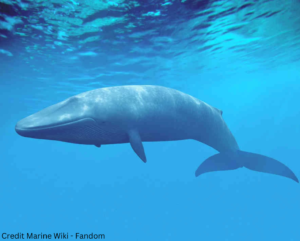Interspecies hanky panky between fin and blue whales may be more common than previously believed, at least in some regions of the world, according to new research.
The genome sequencing of North Atlantic blue whales (Balaenoptera musculus musculus) has shown that approximately 3.5 percent of the group’s DNA originated from fin whales (Balaenoptera physalus), a nearby species.
The scientists from Norway and Canada were surprised by how high this percentage was. Additionally, they found that all of the modern blue whale samples in their research had at least some fin whale DNA—a phenomenon known as introgression—in their genomes.

According to data scientist Sushma Jossey of the Royal Ontario Museum and colleagues, “our results provide the first insights into the population structure, and demographic history of blue whales from the North Atlantic, and document levels of introgression with fin whales.” The study was published online.
Remarkably, the majority of hybrid creatures—that is, animals that are the progeny of two distinct species—tend to be sterile. You may have heard this regarding the mule, a hybrid of a donkey and a horse, or the liger, a hybrid of a lion and a tiger.
The offspring of infertile hybrids lack the necessary genetic material to develop viable sperm or eggs, but their parents must be similar enough to breed in the first place.
The rorqual group of whales, which includes fin and blue whales, has certain genetic traits, according to a 2018 study, therefore hybridization is not completely doomed.
The reason for this could be that, unlike other infertile hybrids, the species has not split apart significantly enough on the evolutionary tree to render their DNA incompatible.
They both share the same chromosomal pattern, which is visible in a genetic test known as C-banding, and have 44 pairs of chromosomes.
In 1986, a pregnant hybrid fin/blue whales carrying a foetus fathered by a blue whale was sighted in Icelandic waters, marking the first instance of a fertile cetacean hybrid. Therefore, it is very evident how the fin whale DNA ended up in these blue whales.
Fascinatingly, introgression—the term for the interchange of DNA across species—seems to be a bit one-sided in this instance.
Even though fin whales have a fair amount of “fin” in them, they don’t seem to receive blue whale DNA in the same manner as blue whales, according to earlier research.
Read More Articles
BMW will use the Super Bowl to promote its first electrified i5 vehicle.
Get the free Skull and Bones game starting on February 16 and learn about its introduction.
With the most recent Arc graphics drivers, Intel promises a 268% gaming increase.
Since technology made it possible for people to hunt these swift giants—which started in the Northern Atlantic, the study region in question—their numbers have been in jeopardy, pushing the species towards extinction. And it never fully bounces back.
So what harm can come from a little interspecies romance amongst whales?
One could argue that having the option to reproduce with other whale species that are similar to their own means that there are more potential mates available, which is preferable to circumstances where falling numbers result in inbreeding, which could be harmful to an already vulnerable species.
However, a significant component of genetic diversity is also speciation. The disappearance of one species from the other is not all that dissimilar from the blurring of boundaries between two species to the point of indistinguishability.
Variations in Climate and Genetic Intrusion
Concerns concerning the possible effects of genetic introgression on the quantity of blue whale DNA present in the population are also brought up by this study. When hybrid individuals repeatedly backcross, genes from one species are introduced into the gene pool of another, a phenomenon known as genetic introgression occurs.
The ability of the blue whale population to adapt to new problems, including climate change induced by humans, may be impacted if this process is widespread.
Quick Evolution: An Effective Remembrance?
The capacity of a species to rapidly adjust to shifting environmental conditions is essential in the context of climate change. As an article on Australian Geographic pointed out, several species have evolved to withstand higher temperatures and pollutants, such as the Atlantic killifish and green algae.
In a similar vein, genetic variety and hybridization may be crucial in assisting species—like the blue whale—to adjust to their environment.
In a Changing Climate: Winners and Losers
The animal kingdom will see both victors and losers as the temperature rises. While some creatures might be more adaptive than others in adjusting to climate change, others might not be able to relocate or change their behaviour. The task of predicting how these changes would affect future ecosystems is difficult, made more difficult by elements like genetic variety and hybridization.